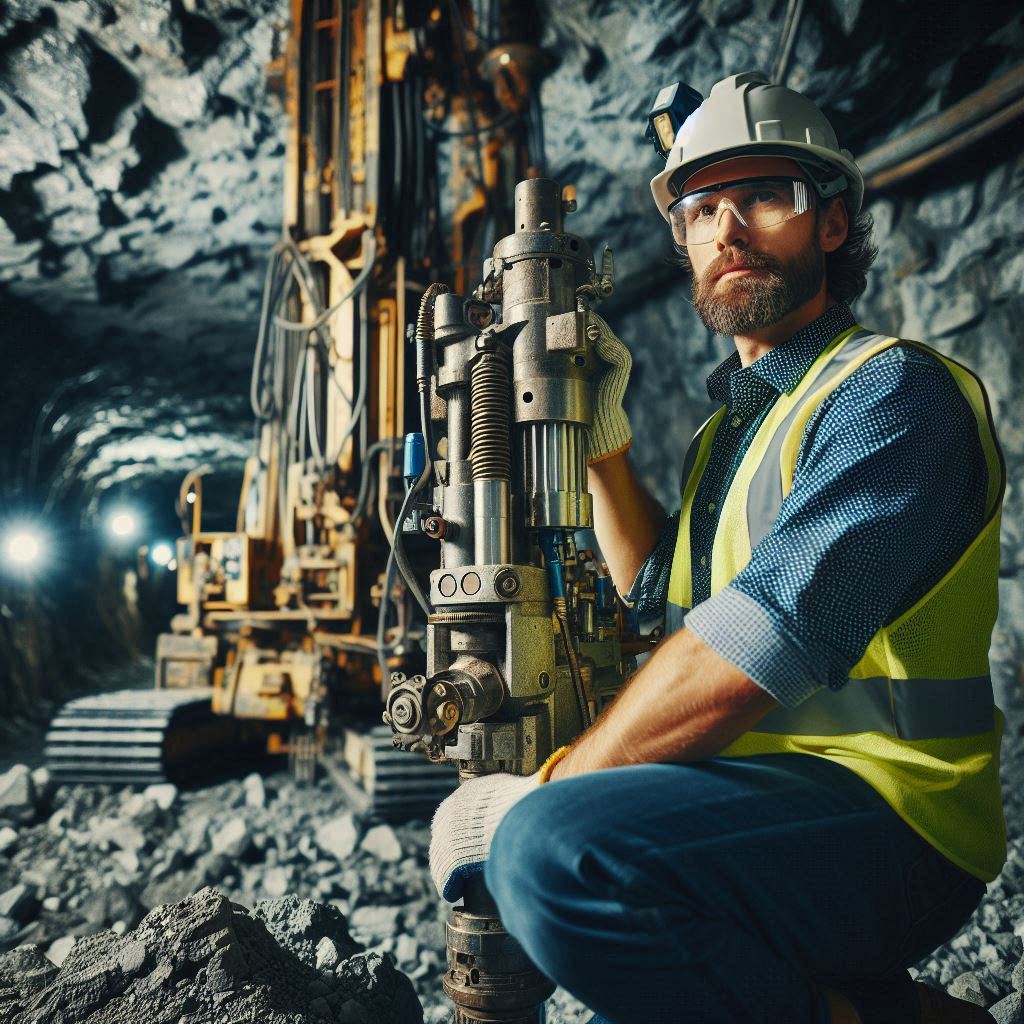Introduction
Environmental engineering focuses on developing solutions to environmental problems.
Environmental engineers work to improve and protect natural resources.
Their role is crucial in addressing issues like pollution, waste management, and climate change.
Environmental engineers design systems to reduce pollution and improve public health.
They develop technologies to clean water, treat waste, and monitor air quality.
Their work helps ensure a sustainable future for our planet.
They play a vital role in industries, ensuring that environmental regulations are followed and that operations are sustainable.
In today’s world, the importance of environmental engineers cannot be overstated.
They help mitigate the impacts of industrial activities on the environment.
With increasing urbanization and industrialization, their expertise is needed more than ever.
They are at the forefront of efforts to combat climate change and reduce carbon footprints.
Their work helps protect ecosystems and biodiversity, ensuring that natural habitats are preserved.
However, environmental engineers face several common challenges in their work.
One major challenge is keeping up with rapidly changing environmental regulations.
Laws and standards are constantly evolving, and engineers must stay informed to ensure compliance.
This requires continuous education and adaptation to new rules and technologies.
Lack of public awareness
How Many people are unaware of the role of environmental engineers
Environmental engineers play a crucial role in addressing environmental challenges and implementing solutions to protect our planet.
However, one of the common challenges faced by these professionals is the lack of public awareness about their role and contributions.
How This lack of awareness can hinder progress in solving environmental issues
Many people are unaware of the specific responsibilities and expertise of environmental engineers.
This lack of awareness can lead to misconceptions about their work and the importance of environmental engineering in addressing issues such as pollution, resource depletion, and climate change.
Without a clear understanding of the role of environmental engineers, it can be difficult to garner support for initiatives aimed at mitigating environmental problems.
Public awareness and engagement are essential for implementing effective solutions and driving sustainable change.
To address this challenge, educational campaigns can be launched to inform the public about the important work of environmental engineers.
These initiatives can include outreach programs in schools, universities, and community centers to raise awareness about environmental issues and the role of engineers in addressing them.
Community outreach efforts can also help bridge the gap between environmental engineers and the public.
By engaging with local communities, professionals can build relationships, establish trust, and communicate the importance of their work in a way that resonates with people from diverse backgrounds.
Moreover, collaborating with media outlets and influencers can help amplify the message and reach a wider audience.
By leveraging social media and other communication channels.
Environmental engineers can effectively communicate their expertise and showcase the impact of their projects on the environment and society.
In addition, partnerships with environmental organizations, government agencies.
And industry stakeholders can provide opportunities to promote the work of environmental engineers and highlight the value they bring to sustainable development efforts.
Solutions for increasing public awareness include educational campaigns and community outreach
By raising public awareness about the role of environmental engineers and the importance of their work.
We can build a more informed and engaged society that supports initiatives to protect the environment and promote sustainability.
Through education, outreach, and collaboration, we can overcome the challenge of lack of public awareness and work towards a more sustainable future.
Regulatory issues
The Complex Regulations that Environmental Engineers Must Navigate
Environmental engineers often navigate a maze of complex regulations.
These rules ensure environmental protection and public safety.
However, the complexity of these regulations can pose significant challenges.
Compliance with local, state, and federal laws requires meticulous attention to detail.
How Changing Regulations Can Present Challenges in Project Management
Changing regulations further complicate project management.
Environmental engineers must stay updated with new laws and amendments.
This constant evolution of rules can disrupt ongoing projects.
Engineers must adapt plans to meet new requirements, causing delays and increased costs.
Examples of Specific Regulations that Have Posed Challenges in the Past
An example of challenging regulations is the Clean Air Act.
This law aims to control air pollution on a national level.
Environmental engineers must ensure that their projects do not violate its standards.
The Act’s frequent updates demand continuous monitoring and adjustments.
The Resource Conservation and Recovery Act (RCRA) is another complex regulation.
It governs the disposal of hazardous waste.
Environmental engineers must design waste management systems that comply with RCRA standards.
Changes to this Act can affect waste disposal methods and project timelines.
Water quality regulations also present challenges.
The Clean Water Act regulates discharges of pollutants into water bodies.
Environmental engineers must design projects to prevent water contamination.
Any changes to this Act can require significant project modifications.
The National Environmental Policy Act (NEPA) requires environmental impact assessments for federal projects.
Environmental engineers must conduct thorough assessments and prepare detailed reports.
Changes in NEPA guidelines can lead to additional research and documentation.
Endangered Species Act (ESA) regulations protect threatened and endangered species.
Environmental engineers must ensure that projects do not harm these species or their habitats.
Compliance with ESA can be particularly challenging in areas with diverse wildlife.
Navigating State-Specific Regulations and Ensuring Compliance
State-specific regulations add another layer of complexity.
Each state may have unique environmental laws that differ from federal regulations.
Environmental engineers must be familiar with these state laws to ensure full compliance.
Navigating these regulatory issues requires expertise and adaptability.
Environmental engineers must develop strategies to manage regulatory changes effectively.
This involves staying informed about legislative updates and participating in industry forums and training.
Regulatory compliance is crucial for project approval and success.
Non-compliance can lead to legal penalties, project shutdowns, and reputational damage.
Environmental engineers play a critical role in ensuring that projects meet all regulatory standards.
In summary, regulatory issues present significant challenges for environmental engineers.
They must navigate complex and ever-changing regulations to ensure compliance.
Examples like the Clean Air Act, RCRA, Clean Water Act, NEPA, and ESA illustrate the challenges posed by specific regulations.
Despite these challenges, environmental engineers remain dedicated to protecting the environment and public health through diligent regulatory compliance.
Read: Comparison: Architecture Styles across American Regions.
Limited financial resources
The Issue of Limited Financial Resources for Environmental Projects
Environmental engineers often grapple with limited financial resources.
These budget constraints can severely impact the effectiveness of environmental projects.
Projects aimed at enhancing air quality, managing waste, or restoring ecosystems require substantial funding.
However, many initiatives face tight budgets that limit their scope and quality.
Engineers may need to prioritize certain aspects of a project while deferring others, leading to incomplete solutions.
How Budget Constraints Can Impact the Effectiveness of Environmental Engineering Solutions
Budget constraints affect the effectiveness of environmental engineering solutions in several ways.
Limited funds can restrict the use of advanced technologies and comprehensive research.
Engineers may be forced to rely on outdated methods that do not fully address environmental issues.
This can result in suboptimal solutions that fail to leverage recent advancements in technology.
Additionally, budget limits may prevent thorough testing and refinement of solutions, reducing their overall impact.
Suggestions for Maximizing Resources and Finding Alternative Funding Sources
To maximize resources and overcome financial constraints, environmental engineers can employ several strategies.
First, seeking partnerships with organizations such as academic institutions, non-profits, or private companies can provide additional support.
These collaborations offer financial assistance and technical expertise, helping to reduce overall costs.
Engineers can also focus on cost-effective technologies and solutions, prioritizing options with lower initial costs and high long-term benefits.
Second, exploring alternative funding sources can provide crucial financial support.
Engineers should apply for grants from government agencies or private foundations dedicated to environmental causes.
Crowdfunding and community fundraising can also be effective in gathering support for specific projects.
Engaging with local businesses and stakeholders for sponsorships or donations can further enhance funding opportunities.
Third, implementing incremental approaches can help manage limited resources effectively.
Phased project implementation allows engineers to use available resources gradually while demonstrating early successes.
This approach can attract additional funding and support for subsequent phases.
Finally, focusing on efficient project management ensures that funds are used effectively.
Careful planning, monitoring, and evaluation can identify and address potential issues early, reducing the risk of overspending.
Basically, addressing limited financial resources requires creative strategies and efficient management.
By forming partnerships, exploring alternative funding, and focusing on cost-effective solutions, environmental engineers can maximize their impact despite financial constraints.
ng innovation, and seeking alternative funding sources, engineers can overcome financial constraints and deliver successful environmental solutions.
Read: 5 Essential Software Tools Every US Architect Uses.
Technological Advancements
How Rapidly Evolving Technology Can Be Both a Blessing and a Curse for Environmental Engineers
Technological advancements are rapidly transforming the field of environmental engineering.
These changes bring both opportunities and challenges.
On one hand, new tools and innovations enable engineers to tackle environmental issues more effectively.
Advanced technologies can streamline processes, improve data accuracy, and enhance problem-solving capabilities.
However, the fast pace of technological evolution can also present significant hurdles for environmental engineers.
Staying current with the latest tools and innovations is crucial yet challenging.
New technologies emerge constantly, making it difficult to keep up.
Environmental engineers must continuously learn and adapt to avoid falling behind.
This relentless pace of change can be overwhelming and demanding.
The Challenges of Staying Current with the Latest Tools and Innovations
One major challenge is the time and effort required to learn new technologies.
Engineers must invest in ongoing education and training.
This can be time-consuming and may divert attention from other important tasks.
Additionally, integrating new tools into existing workflows can be complex and disruptive.
Another challenge is the cost associated with adopting new technologies.
Advanced tools and equipment often come with high price tags.
Budget constraints can limit access to the latest innovations, particularly for smaller firms or individual practitioners.
Balancing the need for cutting-edge technology with financial realities is a common struggle.
Moreover, technological advancements can create a skills gap.
Not all engineers have the same level of proficiency with new tools.
Bridging this gap requires targeted training and professional development.
Without adequate support, some engineers may struggle to effectively use new technologies, impacting their performance and productivity.
Tips for Keeping Up-to-Date with Technology in the Field
To navigate these challenges, environmental engineers can take several proactive steps.
First, prioritizing continuous learning is essential.
Engineers should seek out educational opportunities, such as workshops, webinars, and courses.
Staying informed about industry trends and advancements can help engineers anticipate and prepare for changes.
Networking with peers and industry professionals is also valuable.
Joining professional organizations and attending conferences can provide insights into emerging technologies.
Engaging with a community of practice allows engineers to share knowledge and experiences.
This collaborative approach can facilitate the adoption of new tools and techniques.
Additionally, leveraging online resources can be beneficial.
Numerous websites, forums, and online platforms offer information and tutorials on the latest technologies.
Engineers can use these resources to enhance their understanding and skills.
Subscribing to industry publications and newsletters can also keep engineers updated on technological trends.
Another tip is to start small when adopting new technologies.
Piloting new tools on a smaller scale can help engineers assess their effectiveness before full implementation.
This approach allows for gradual integration and minimizes disruption.
Finally, seeking support from employers or institutions can make a significant difference.
Advocating for training programs and funding for new technologies can help bridge the skills gap.
Employers who invest in their engineers‘ professional development can enhance overall team performance.
Most importantly, while rapidly evolving technology presents challenges for environmental engineers, it also offers immense potential.
By staying proactive and engaged, engineers can successfully navigate these advancements.
Embracing continuous learning, networking, and leveraging resources are key strategies to stay current and excel in this dynamic field.
Read: Decoding the Ethics & Responsibilities of US Civil Engineers
Climate Change
How Climate Change Presents Unique Challenges for Environmental Engineers
Climate change presents unique challenges for environmental engineers.
The increasing frequency of extreme weather events complicates infrastructure design.
Rising sea levels threaten coastal areas and necessitate innovative engineering solutions.
Environmental engineers must adapt to these evolving conditions to protect communities and ecosystems.
The Role of Environmental Engineers in Addressing Climate-Related Issues
Environmental engineers play a crucial role in addressing climate-related issues.
They design systems to manage stormwater and prevent flooding.
By developing sustainable practices, they reduce carbon footprints and mitigate the effects of climate change.
Their work involves creating resilient structures that can withstand harsh weather conditions.
One significant challenge is managing water resources.
Climate change affects precipitation patterns, leading to droughts and floods.
Environmental engineers develop efficient water management systems to ensure a reliable supply.
They implement rainwater harvesting and greywater recycling to conserve water resources.
Another challenge is maintaining air quality.
Increased temperatures and pollution levels exacerbate air quality issues.
Environmental engineers design air filtration systems and promote the use of cleaner energy sources.
They work on reducing emissions from industrial processes and transportation.
Insights into How Environmental Engineers Can Adapt and Innovate in the Face of Climate Change
Environmental engineers must innovate to meet these challenges.
They use advanced technologies like remote sensing to monitor environmental changes.
By analyzing data, they can predict and respond to climate impacts effectively.
This proactive approach helps in designing adaptive strategies.
Collaboration is key in addressing climate change.
Environmental engineers work with policymakers to develop regulations that promote sustainability.
They engage with communities to raise awareness and implement local solutions.
By fostering partnerships, they create comprehensive strategies to tackle climate issues.
Environmental engineers can adapt by embracing new materials and technologies.
For instance, they can use permeable pavement to reduce runoff and improve water quality.
Incorporating green roofs and walls can enhance insulation and reduce urban heat islands.
These innovations contribute to sustainable urban development.
Education and continuous learning are vital for environmental engineers.
Keeping up with the latest research and technologies enables them to address emerging climate challenges.
Professional development opportunities and certifications help them stay current and effective in their roles.
Environmental engineers also focus on renewable energy solutions.
They design wind, solar, and geothermal energy systems to reduce reliance on fossil fuels.
By promoting clean energy, they help mitigate greenhouse gas emissions and combat climate change.
Adaptation strategies are essential for long-term resilience.
Environmental engineers assess vulnerabilities and develop plans to protect critical infrastructure.
They incorporate climate projections into their designs to ensure future readiness.
This forward-thinking approach helps safeguard communities against climate impacts.
Public engagement is crucial in climate adaptation.
Environmental engineers communicate the importance of sustainable practices to the public.
By involving communities in decision-making, they ensure the successful implementation of climate initiatives.
Engaging stakeholders fosters a sense of ownership and commitment to environmental goals.
Generally, climate change presents significant challenges for environmental engineers.
Their role in addressing these issues is vital for community resilience.
By adapting, innovating, and collaborating, environmental engineers can effectively manage the impacts of climate change.
They must continue to learn and evolve to protect our planet for future generations.
Transform Your Career Today
Unlock a personalized career strategy that drives real results. Get tailored advice and a roadmap designed just for you.
Start NowRead: Top Cities for Electrical Engineering Jobs in America

Interdisciplinary Collaboration
Importance of collaboration with other professionals, such as scientists and policymakers
Collaboration with professionals from various fields is essential in environmental engineering.
Scientists and policymakers provide critical expertise and insights.
Working with scientists helps environmental engineers understand complex ecological systems and the impact of engineering projects.
Policymakers ensure that environmental projects comply with regulations and align with public policy goals.
This interdisciplinary approach leads to well-rounded and effective solutions.
The challenges of working with diverse teams and balancing different perspectives
However, working with diverse teams presents challenges.
Engineers, scientists, and policymakers often have different priorities and methods.
Engineers focus on technical feasibility and efficiency.
Scientists prioritize ecological accuracy and data integrity.
Policymakers aim for regulatory compliance and public acceptance.
Balancing these perspectives requires effective communication and negotiation skills.
Differing terminologies can also create confusion.
Engineers, scientists, and policymakers use jargon specific to their fields.
Misunderstandings may arise when team members fail to clarify terms.
Clear and concise communication is vital to overcoming this challenge.
Team members should take the time to explain their terminology and concepts to ensure everyone is on the same page.
Another challenge is coordinating schedules and availability.
Professionals from different fields may have varying work hours and commitments.
Scheduling regular meetings that accommodate everyone can be difficult.
Using digital collaboration tools can help.
Tools like video conferencing, shared documents, and project management software facilitate communication and coordination.
Balancing different perspectives involves considering each team member’s input equally.
Engineers should listen to scientists’ ecological concerns and policymakers’ regulatory advice.
Conversely, scientists and policymakers should appreciate engineers’ technical constraints.
Encouraging open discussions where all viewpoints are valued fosters mutual respect and understanding.
Strategies for effective interdisciplinary collaboration in environmental engineering projects
To achieve effective interdisciplinary collaboration, establish clear goals and roles from the beginning.
Define each team member’s responsibilities and expectations.
Having a structured plan helps prevent misunderstandings and ensures everyone works towards the same objectives.
Regular progress reviews can also keep the team aligned and address any emerging issues.
Active listening is another key strategy.
Environmental engineers should actively listen to their colleagues’ insights and concerns.
This involves not only hearing the words but also understanding the underlying ideas and motivations.
Active listening promotes empathy and strengthens team cohesion.
Conflict resolution skills are essential in interdisciplinary teams.
Differences in opinion are inevitable.
Address conflicts promptly and constructively.
Encourage open dialogue where team members can express their views without fear of retribution.
Mediation techniques can help resolve disputes and maintain a positive working environment.
Investing in team-building activities can also enhance collaboration.
Activities that foster trust and camaraderie improve team dynamics.
Consider organizing workshops, training sessions, or informal gatherings to build relationships and improve teamwork.
Interdisciplinary collaboration in environmental engineering is crucial for creating comprehensive solutions.
By addressing the challenges of diverse teams, balancing perspectives, and implementing effective strategies, environmental engineers can lead successful collaborative projects.
This approach not only enhances project outcomes but also contributes to sustainable and impactful environmental solutions.
See Related Content: Job Outlook for Laboratory Technicians
Learn More: The Role of Agricultural Engineers in Food Safety
Public resistance
The Issue of Public Resistance to Environmental Engineering Projects
Environmental engineers frequently encounter public resistance to their projects.
This opposition can significantly hinder progress and delay essential environmental initiatives.
Addressing this issue requires a clear understanding of the underlying causes of resistance and effective strategies to mitigate it.
The Reasons Behind Public Opposition and Skepticism
Public resistance often arises from a lack of understanding about the project’s benefits.
People may feel uninformed about the environmental, economic, or social advantages of proposed changes.
This lack of information can lead to skepticism and opposition.
Fear of negative impacts also contributes to resistance.
Communities might worry about potential health risks, environmental degradation, or changes to their local lifestyle.
Past negative experiences or media coverage can amplify these fears, further fueling opposition.
Economic concerns are another major factor.
People might be apprehensive about the costs associated with environmental projects, including potential increases in taxes or economic burdens.
Such concerns can lead to resistance if not properly addressed.
Suggestions for Overcoming Resistance and Building Support for Environmental Initiatives
To overcome public resistance, environmental engineers should prioritize clear and open communication.
Engaging with the community early in the project can help build trust and understanding.
Providing transparent information about the benefits, risks, and costs of the project can address fears and reduce skepticism.
Educational outreach is crucial.
Hosting public forums, workshops, or information sessions helps explain the project‘s goals and advantages.
By involving experts and presenting credible data, engineers can counter misinformation and build credibility.
Engaging stakeholders in the decision-making process can foster cooperation and support.
Allowing community members to voice their concerns and participate in discussions can lead to more positive attitudes toward the project.
This inclusion can help address specific local issues or objections.
Developing partnerships with local organizations can enhance credibility and support.
Collaborating with community groups, businesses, and other stakeholders can spread positive messages and address concerns.
These partnerships also help in tackling any specific local issues or objections.
Addressing public concerns with practical solutions is essential.
For instance, if there are worries about health impacts, engineers can conduct thorough risk assessments and share the results with the community.
Implementing additional safety measures or mitigation strategies can alleviate fears and show commitment to public welfare.
Finally, showcasing successful case studies and best practices can build support.
Demonstrating how similar projects have benefited other communities provides reassurance and inspires confidence.
Highlighting tangible results and positive outcomes can shift public perception from skepticism to support.
In summary, overcoming public resistance involves clear communication, community engagement, and practical solutions.
By addressing concerns proactively and building trust, environmental engineers can gain support and ensure the successful implementation of their projects.
Burnout and stress
One common challenge faced by environmental engineers is burnout and stress.
Acknowledging the high-pressure nature of environmental engineering work
Environmental engineers often find themselves working in fast-paced environments where they are expected to meet tight deadlines and deliver high-quality results consistently.
This pressure can take a toll on their mental health and well-being.
The risk of burnout and mental health challenges in the field
Burnout is a real risk for environmental engineers due to the demanding nature of their work.
Long hours, tight schedules, and the need to constantly juggle multiple projects can lead to exhaustion and feelings of overwhelm.
Additionally, the nature of the work, which often involves dealing with complex technical issues and navigating regulatory frameworks, can contribute to high levels of stress.
Tips for managing stress and maintaining a healthy work-life balance
Set boundaries
It’s essential for environmental engineers to establish clear boundaries between work and personal life.
This means setting specific work hours, not checking emails outside of those hours, and prioritizing activities that help them unwind and relax.
Take breaks
Regular breaks are crucial for maintaining productivity and mental well-being.
Environmental engineers should make it a point to take short breaks throughout the day and disconnect from work during lunchtime to recharge and refocus.
Practice self-care
Engaging in activities that promote self-care, such as exercise, meditation, or hobbies, can help environmental engineers relieve stress and maintain a healthy work-life balance.
It’s important to prioritize self-care activities and make time for them regularly.
Seek support
Environmental engineers should not hesitate to seek support from colleagues, mentors, or mental health professionals when needed.
Talking about challenges and seeking guidance can help them manage stress and prevent burnout.
Set realistic goals
Setting realistic goals and expectations for projects can help environmental engineers avoid feeling overwhelmed or burnt out.
Breaking down projects into manageable tasks and setting achievable milestones can make the workload more manageable.
Delegate tasks
Learning to delegate tasks and collaborate with team members can help environmental engineers distribute work more effectively and reduce individual stress levels.
Delegating tasks where possible can help prevent burnout and improve efficiency.
Practice mindfulness
Mindfulness practices, such as meditation or deep breathing exercises, can help environmental engineers stay present, calm, and focused amidst the chaos of work.
Practicing mindfulness regularly can reduce stress levels and improve overall well-being.
By acknowledging the high-pressure nature of environmental engineering work, recognizing the risk of burnout and mental health challenges.
And implementing practical strategies for stress management and work-life balance, environmental engineers can navigate challenges more effectively and sustain fulfilling careers in the field.
Transform Your Career Today
Unlock a personalized career strategy that drives real results. Get tailored advice and a roadmap designed just for you.
Start NowDiscover More: Average Salary of Solar PV Installers in Different States
Conclusion
Environmental engineers face numerous challenges that test their skills and resolve.
Key challenges include managing pollution, ensuring sustainable resource use, and addressing climate change impacts.
They grapple with the complexities of waste management and the need for innovative technologies to mitigate environmental damage.
Additionally, regulatory compliance and public perception often add layers of difficulty to their roles.
Addressing these challenges is crucial for the continued success and effectiveness of environmental engineering.
Effective pollution control and sustainable resource management help preserve ecosystems and human health.
Tackling climate change requires engineers to develop and implement strategies that reduce greenhouse gas emissions and enhance resilience.
Without solutions to these pressing issues, the quality of our environment could deteriorate, impacting future generations.
Supporting environmental engineers in their work is vital.
Advocacy and public support can lead to increased funding and resources for research and development.
It also helps to create policies that prioritize environmental sustainability.
Encouraging collaboration between engineers, policymakers, and communities can drive meaningful progress and foster innovative solutions.




